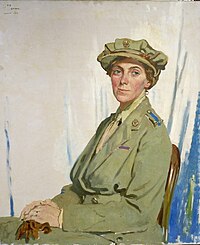Helen Gwynne-Vaughan
Dame Helen Gwynne-Vaughan GBE | |
|---|---|
 Portrait by William Orpen, 1918 | |
| Birth name | Helen Charlotte Isabella Fraser |
| Born | 21 January 1879 Westminster, London, England |
| Died | 26 August 1967 (aged 88) Storrington, Sussex, England |
| Allegiance | United Kingdom |
| Service/ | Auxiliary Territorial Service |
| Rank | Director |
| Unit | First Chief Controller, Queen Mary's Army Auxiliary Corps (QMAAC) in France |
| Commands held | Women's Royal Air Force |
| Spouse(s) | David Thomas Gwynne-Vaughan (m. 1911–1915, his death) |
Dame Helen Charlotte Isabella Gwynne-Vaughan,
Early life and education
Helen Charlotte Isabella Fraser was born on 21 January 1879 in
Due to her stepfather's career, Fraser spent a large amount of her youth living abroad and was educated mainly by governesses.[1] From 1895 to 1896, she was educated at Cheltenham Ladies' College, an all-girls private boarding school in Cheltenham, Gloucestershire.[1][3]
In 1899, she attended the ladies' department of
Career
Academic career
Having completed her bachelor's degree, she spent 1904 working as a
In 1920 she applied for the
Military service
In 1917, she was appointed Controller of the
Gwynne-Vaughan was first made Chief Controller of the Auxiliary Territorial Service (ATS) in 1939.[7] This was a role that Mary Baxter Ellis had turned down as she preferred to lead the volunteer First Aid Nursing Yeomanry (FANYs). Ellis agreed however to supply 1500 women to serve with the ATS as long as the rest of the FANY could be independent. This was agreed but Gwynne-Vaughan broke the agreement and forced the FANY to be absorbed.[9] Gwynne-Vaughan held the role to 1941.[7]
Other work
Gwynne-Vaughan was interested in politics. While she was at Royal Holloway College she and Louisa Garrett Anderson co-founded the University of London Suffrage Society.[10] In 1926 she spoke as part of a National Union of Societies for Equal Citizenship meeting.[11]
She stood in the
She was also active in
After her retirement in 1944 she was the full-time honorary secretary of the London branch of the Soldiers', Sailors' and Air Force Association until 1962.[10]
Personal life
In 1911, she married
Honours and distinctions
In the
She was elected to the
She was the president of the British Mycological Society in 1928.[10]
Fungal species named in her honour include Palaeoendogone gwynne-vaughaniae[17] and Pleurage gwynne-vaughaniae.[18]
English Heritage unveiled a blue plaque in Gwynne-Vaughan's honour in March 2020, placed on the house on Bedford Avenue in Bloomsbury London, where she lived for nearly 50 years.[19]
References
- ^ doi:10.1093/ref:odnb/33623. (Subscription or UK public library membershiprequired.)
- ^ Burke's Peerage, Baronetage and Knightage, 107th edition, ed. Charles Mosley, Burke's Peerage Ltd, 2003, vol. 1 p. 1411, vol. 3 p. 3513
- ^ )
- ^ ISBN 978-1860645020.
- , p. 116, Taylor & Francis US, 2000.
- ^ Noakes, Lucy. Women in the British Army Routledge, 2006, p. 68
- ^ doi:10.1093/ref:odnb/33623. (Subscription or UK public library membershiprequired.)
- ^ "Commandant of the WRAF September 1918-December 1919". Archived from the original on 5 August 2010. Retrieved 27 June 2010.
- required.)
- ^ a b c Dearnley, Elizabeth. "Fungi and the forces: The pioneering life of Helen Gwynne-Vaughan". University of London. Retrieved 20 May 2020.
- ^ "The". The Woman Teacher (Vol. 7 No. 34 ed.). London, UK: National Union of Women Teachers. 1926. p. 5.
- ^ https://www.nytimes.com/1967/08/31/archives/dame-helen-gwynnevaughan-botanist-and-army-leader-dies.html
- ^ "No. 31378". The London Gazette (Supplement). 30 May 1919. p. 7026.
- ^ "No. 33501". The London Gazette (Supplement). 31 May 1929. p. 3675.
- OCLC 773504359.
- ^ Beharrell, Will; Douglas, Gina. "New Exhibition: Celebrating the Linnean Society's First Women Fellows". The Linnean Society of London. Retrieved 20 May 2020.
- PMID 24750009.
- .
- ^ "Six New Blue Plaques for Women". English Heritage. Retrieved 4 March 2020.
Sources
- Kerr, Rose(1976). Story of the Girl Guides 1908-1938. London: Girl Guides Association.
- Noakes, Lucy (2006). Women in the British Army; War and the Gentle Sex, 1907-1948. London: Routledge.
- Creese, Mary R. S. (September 2004). "Vaughan, Dame Helen Charlotte Isabella Gwynne- (1879–1967)". doi:10.1093/ref:odnb/33623. (Subscription or UK public library membershiprequired.)
